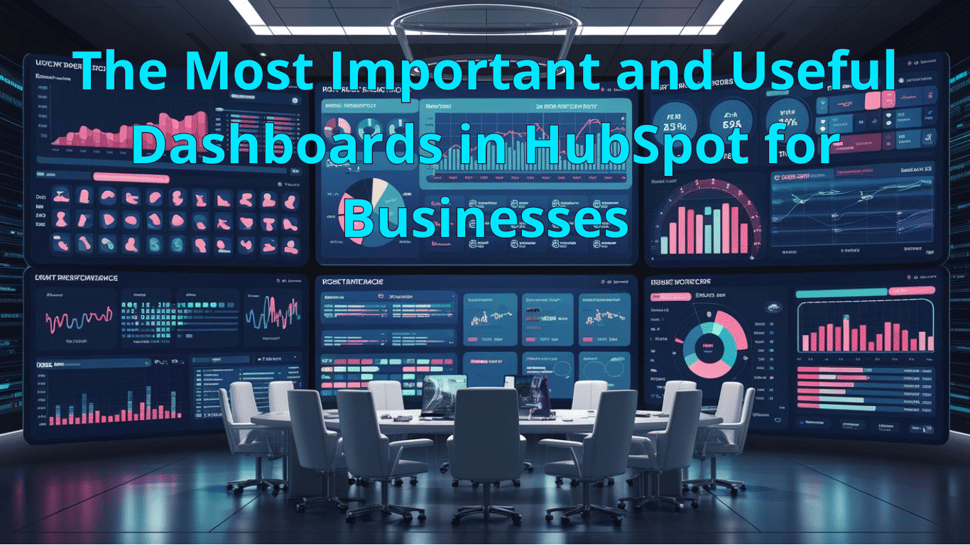
Blog Details
The Most Important and Useful Reporting Dashboards in HubSpot for Businesses
- January 29 2025
- Nikias Kray

In today’s data-driven business landscape, leveraging HubSpot dashboards is essential for gaining actionable insights and making informed decisions. By customizing these dashboards, businesses can monitor key performance indicators (KPIs) across various departments, ensuring alignment with strategic goals.
Key HubSpot Dashboards for Business Success
1. Contact Analysis Dashboard
Understanding your contacts is crucial for creating effective marketing campaigns and nurturing relationships. This dashboard provides insights into your contact database, enabling businesses to:
-
Segment contacts based on demographics, behavior, or lifecycle stage. For example, you can create lists of high-value customers or re-engage dormant leads.
-
Identify high-potential leads by analyzing activity such as website visits, email opens, or form submissions.
-
Refine communication strategies by evaluating engagement trends, such as which types of content perform best.
With the Contact Analysis Dashboard, businesses can ensure they are targeting the right audience with the right message, driving higher conversion rates and stronger customer relationships.

2. Company Insights Dashboard
For B2B enterprises, monitoring company-level interactions is vital for managing accounts effectively. This dashboard allows you to:
-
Assess account health by tracking interactions and activities associated with each company. For instance, see which companies are most engaged with your brand.
-
Identify cross-sell and upsell opportunities by understanding product interest and purchase history.
-
Evaluate engagement trends to prioritize resources on high-value accounts.
By consolidating data at the company level, this dashboard helps sales teams focus on strategic accounts and foster long-term partnerships.
3. Deal Analysis Dashboard
Monitoring your sales pipeline is essential to ensure revenue growth and operational efficiency. The Deal Analysis Dashboard provides key insights into:
-
Deal stages: Track where each deal is in the sales process and identify bottlenecks causing delays.
-
Win/loss rates: Understand why deals are being won or lost to improve sales strategies.
-
Revenue forecasting: Use historical data and current pipeline metrics to predict future income.
Sales managers can use this dashboard to optimize the sales funnel and allocate resources to areas with the highest revenue potential.
4. Sales & Marketing Activity Dashboard
Keeping a pulse on your sales team’s activities is key to improving performance and achieving targets. The Sales Activity Dashboard enables businesses to:
-
Measure outreach efforts such as calls, emails, and meetings conducted by sales reps.
-
Evaluate team performance against predefined goals, identifying top performers and those needing support.
-
Spot training needs by analyzing trends in productivity and outcomes.
This dashboard empowers sales leaders to maintain accountability and foster a culture of continuous improvement.
The marketing activity dashboard keeps track of all marketing activities, including:
- Emails
- Social media
- Website
- Form submissions
- Paid advertising
5. Marketing & Sales Performance Dashboard
Assessing the impact of revenue generating initiatives ensures campaigns are optimized for maximum ROI. The Performance Dashboard helps businesses measure success throughout the entire funnel:
-
Track lead generation sources to determine the most effective channels, such as paid ads, email campaigns, or organic search.
-
Measure conversion rates from marketing campaigns to actual sales.
-
Analyze ROI to allocate budgets more effectively, focusing on strategies that drive results.
With this dashboard, teams can make data-backed decisions to refine their approach and achieve higher engagement and sales.
6. Service Tickets Dashboard
Providing excellent customer service is a competitive advantage. The Service Tickets Dashboard allows support teams to:
-
Monitor ticket resolution times to ensure prompt responses and avoid customer dissatisfaction.
-
Identify common issues that customers face, enabling proactive solutions.
-
Evaluate customer satisfaction using feedback and surveys integrated into the system.
This dashboard enhances the customer experience and builds loyalty by ensuring issues are resolved efficiently.

Benefits of Custom HubSpot Dashboards
Implementing these dashboards offers several advantages:
-
Data-Driven Decisions: Base your strategies on real-time data rather than intuition.
-
Enhanced Collaboration: Share insights across departments to foster a unified approach.
-
Improved Efficiency: Quickly identify areas needing attention, allowing for swift action.
At CRM Magnetics, we specialize in creating tailored HubSpot dashboards that align with your business objectives. Our expertise ensures you harness the full potential of HubSpot’s reporting capabilities, turning data into a strategic asset.
Ready to Transform Your Data Into Actionable Insights?
Contact us today to schedule a free HubSpot strategy call and discover how our custom dashboards can drive your business forward. Visit CRM Magnetics Reporting to learn more and take the next step toward optimizing your operations.
Leave your thought here
Your email address will not be published. Required fields are marked *